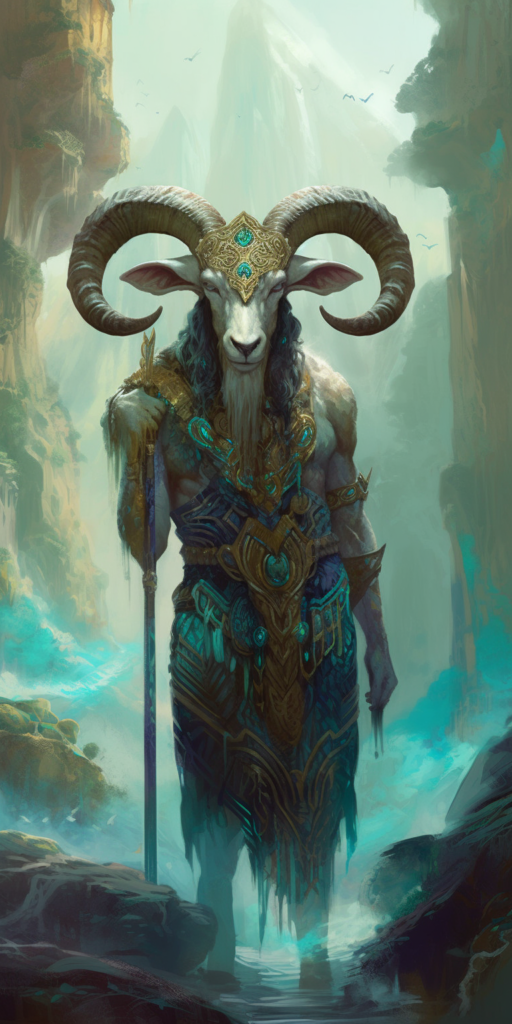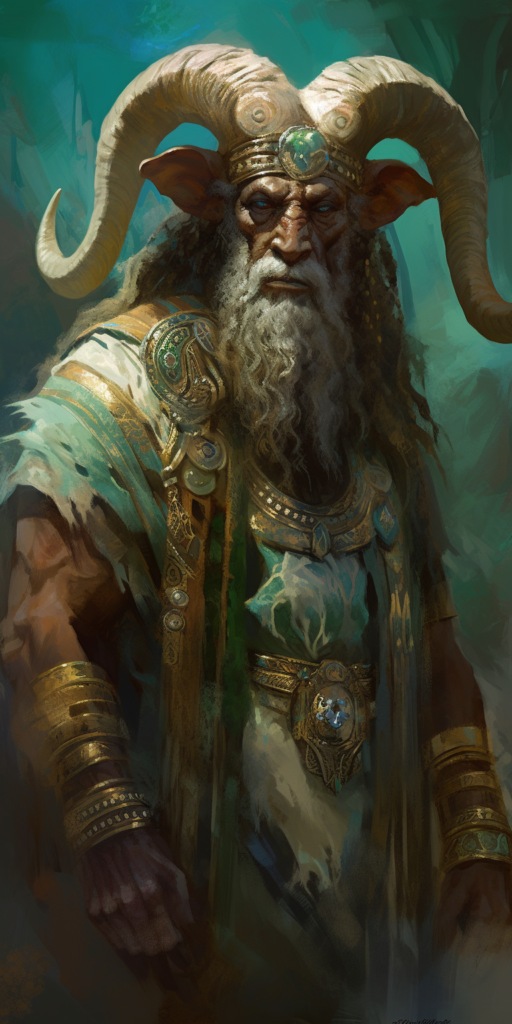Khnum, God of Creation and the Nile
Khnum is an ancient Egyptian deity who is associated with creation, the annual flooding of the Nile, and pottery.

- Pantheon: Egyptian Pantheon
- Deity Title: Khnum, God of Creation and the Nile
- Deity Symbol: The ram-headed god
- Home Plane: Celestia, the Seven Heavens
- Deity Level: Greater Deity
- Alignment: Lawful Neutral
- Aliases: Khnemu, Khnouphis, Khnum-Re
- Superior: None
- Traditional Allies: Hapy, the god of the Nile flood, and Satet, the goddess of the Nile cataracts
- Traditional Foes: Apophis, the god of chaos and the serpent demon who threatened the sun god, Ra
- Divine Artifact: “The Wheel of Creation”
- Servants: Divine craftsmen, potters, and weavers
- Servitor Creatures: None specified
- Sacred Animal: Ram
- Manifestations: Khnum can manifest as a human with a ram’s head or as a fully-formed ram.
- Signs of Favor: Abundant water, successful crops, and the birth of healthy children.
- Worshipers: Artisans, craftsmen, potters, weavers, and those who depend on the Nile for their livelihood.
- Cleric Alignments: Lawful Good, Lawful Neutral, Neutral Good, True Neutral
- Specialty Priests: Potters, craftsmen, and weavers
- Holy Days: The festival of Khnum was celebrated on the first day of the new year.
- Portfolio: Creation, fertility, the Nile, and pottery.
- Domains: Earth, Creation, Water, and Protection.
- Favored Weapon: Staff
- Favored Class: Cleric
- Favored Race: Humans
- Duties of the Priesthood: The priesthood of Khnum is responsible for the maintenance and repair of temples, as well as the creation of pottery and other crafts.
- Major Cult/Temple Sites: The temple of Khnum at Elephantine, near modern-day Aswan, was the most important center of his worship.
- Benefits: The priesthood of Khnum receives divine aid in their craftwork and is granted the power to bless water and ensure fertility in crops and livestock.
Khnum is a ram-headed god who stands tall with a muscular build and broad shoulders, emanating an air of wisdom and serenity. His curly locks flow down to his shoulders, framing his youthful face and piercing blue eyes. His thick beard extends down to his chest, and his horns curve inward and meet at the center of his forehead.
He is known as the creator god, believed to have fashioned the first humans out of clay on his potter’s wheel. As the god of the Nile River, he is also revered as a fertility god and associated with the annual inundation of the river that nourishes the crops and brings new life to the land. In his role as a craftsman and protector of artisans, he is often depicted holding a mallet and chisel, as well as a scepter that symbolizes his authority.
Khnum’s primary motivation is to ensure the well-being and prosperity of the people and the land he created. He seeks to maintain the balance of nature and the flow of the Nile, providing the necessary conditions for life and growth. He also takes pride in his craftsmanship and is honored by the work of skilled artisans who honor him with their creations.
Overall, Khnum is a benevolent and nurturing god who embodies the creative spirit and the power of nature. He is a symbol of fertility, creation, and artistic inspiration, revered by both the common people and the ruling elites.
Divine Artifact
The Wheel of Creation
Artifact, requires attunement by a cleric of Khnum
This magical potter’s wheel is made of gleaming ivory and gold, and radiates a powerful aura of creation magic. When attuned to a cleric of Khnum, it grants the following benefits:
- Divine Aid in Craftsmanship. Whenever the attuned cleric uses the Wheel of Creation to craft pottery or other objects, they receive divine guidance and assistance from Khnum. They may add their Wisdom modifier to any ability checks made to craft objects with the wheel.
- Blessing of Fertility. Once per day, the attuned cleric can use the Wheel of Creation to bless a body of water within 30 feet of them. For the next 24 hours, any plants, crops, or animals that rely on that water for their growth or survival gain a +2 bonus to all ability checks and saving throws. In addition, the water itself becomes pure and safe to drink, curing any diseases or poisons.
- Empowerment of the Nile. As an action, the attuned cleric can spin the Wheel of Creation and call upon the power of the Nile itself. A powerful surge of water erupts from the ground, washing away any enemies within 30 feet of the cleric and knocking them prone. In addition, any allies within 30 feet of the cleric gain temporary hit points equal to the cleric’s level, and their movement speed is doubled for the next round.
- Manifestation of Khnum. Once per week, the attuned cleric can use the Wheel of Creation to summon a manifestation of Khnum himself. The god of creation appears in a burst of radiant light, and grants the cleric a single wish related to creation or fertility. The wish must be something that Khnum could feasibly accomplish, and cannot be used to directly harm another creature or grant the cleric immortality or invincibility. After granting the wish, Khnum disappears, and the Wheel of Creation loses this ability until the next week.
- Divine Weapon. The Wheel of Creation can also be wielded as a magical weapon, dealing 2d8 bludgeoning damage on a hit. It has the finesse and thrown properties, and a range of 30 feet. In addition, any creature struck by the Wheel of Creation must succeed on a DC 25 Constitution saving throw or be stunned for 1 minute as they are overwhelmed by a surge of creative energy. A creature that succeeds on the saving throw is immune to this effect for 24 hours.
- Destroying the Wheel. The Wheel of Creation is an artifact, and can only be destroyed by a divine intervention from a deity of equal or greater power than Khnum. If the wheel is destroyed, it explodes in a burst of creative energy, creating a permanent and fertile oasis in a 1-mile radius around the point of destruction. The oasis is always blessed by Khnum, and is considered sacred ground to all who worship him.
Currently in the World

Khnum, the ancient Egyptian god of the Nile, sits on his throne deep in thought. The once mighty river has been faltering as of late, its waters becoming increasingly scarce and polluted with each passing day. Khnum knows that he must act swiftly to save his beloved river and the people who depend on it for their livelihoods.
Over the centuries, Khnum has taken on many forms and played many roles in Egyptian mythology. He is the creator god, who fashioned the first humans from clay on his potter’s wheel. He is the guardian of the source of the Nile, ensuring its flow and purity. And he is the god of fertility, overseeing the birth of both animals and humans.
In the 1450s, Khnum’s main focus is on the Nile and the people who rely on it. He sends his avatar to the riverbanks, where it appears to farmers and fishermen, offering guidance and protection. Khnum also instructs his priests to perform rituals to appease the river and maintain its health.
Despite his best efforts, Khnum is not without his struggles. His power has waned over time, as new religions and beliefs have taken hold in Egypt. He must constantly adapt and evolve to stay relevant and keep his followers.
But Khnum is determined to preserve the Nile and the way of life it sustains. He knows that the river is more than just a source of water; it is a symbol of Egypt’s strength and prosperity. And so, he will continue to fight for the Nile and its people, for as long as he has the power to do so.

 Buy me a coffee
Buy me a coffee